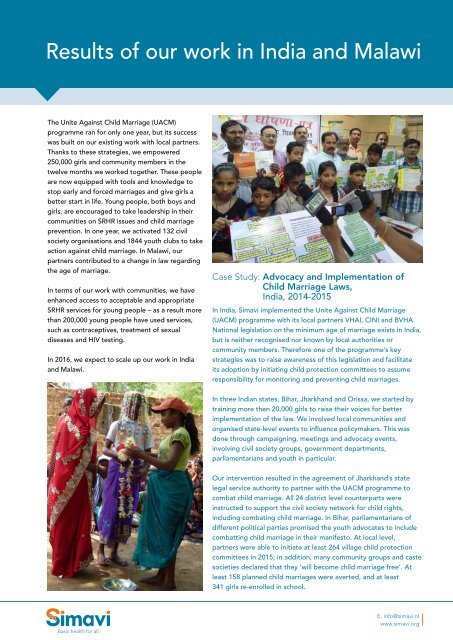Ending Child Marriage
WggAZ
WggAZ
You also want an ePaper? Increase the reach of your titles
YUMPU automatically turns print PDFs into web optimized ePapers that Google loves.
Results of our work in India and Malawi<br />
The Unite Against <strong>Child</strong> <strong>Marriage</strong> (UACM)<br />
programme ran for only one year, but its success<br />
was built on our existing work with local partners.<br />
Thanks to these strategies, we empowered<br />
250,000 girls and community members in the<br />
twelve months we worked together. These people<br />
are now equipped with tools and knowledge to<br />
stop early and forced marriages and give girls a<br />
better start in life. Young people, both boys and<br />
girls, are encouraged to take leadership in their<br />
communities on SRHR issues and child marriage<br />
prevention. In one year, we activated 132 civil<br />
society organisations and 1844 youth clubs to take<br />
action against child marriage. In Malawi, our<br />
partners contributed to a change in law regarding<br />
the age of marriage.<br />
In terms of our work with communities, we have<br />
enhanced access to acceptable and appropriate<br />
SRHR services for young people – as a result more<br />
than 200,000 young people have used services,<br />
such as contraceptives, treatment of sexual<br />
diseases and HIV testing.<br />
In 2016, we expect to scale up our work in India<br />
and Malawi.<br />
Case Study: Advocacy and Implementation of<br />
<strong>Child</strong> <strong>Marriage</strong> Laws,<br />
India, 2014-2015<br />
In India, Simavi implemented the Unite Against <strong>Child</strong> <strong>Marriage</strong><br />
(UACM) programme with its local partners VHAI, CINI and BVHA.<br />
National legislation on the minimum age of marriage exists in India,<br />
but is neither recognised nor known by local authorities or<br />
community members. Therefore one of the programme’s key<br />
strategies was to raise awareness of this legislation and facilitate<br />
its adoption by initiating child protection committees to assume<br />
responsibility for monitoring and preventing child marriages.<br />
In three Indian states, Bihar, Jharkhand and Orissa, we started by<br />
training more then 20,000 girls to raise their voices for better<br />
implementation of the law. We involved local communities and<br />
organised state-level events to influence policymakers. This was<br />
done through campaigning, meetings and advocacy events,<br />
involving civil society groups, government departments,<br />
parliamentarians and youth in particular.<br />
Our intervention resulted in the agreement of Jharkhand’s state<br />
legal service authority to partner with the UACM programme to<br />
combat child marriage. All 24 district level counterparts were<br />
instructed to support the civil society network for child rights,<br />
including combating child marriage. In Bihar, parliamentarians of<br />
different political parties promised the youth advocates to include<br />
combatting child marriage in their manifesto. At local level,<br />
partners were able to initiate at least 264 village child protection<br />
committees in 2015; in addition, many community groups and caste<br />
societies declared that they ‘will become child marriage free’. At<br />
least 158 planned child marriages were averted, and at least<br />
341 girls re-enrolled in school.<br />
E. info@simavi.nl<br />
www.simavi.org



